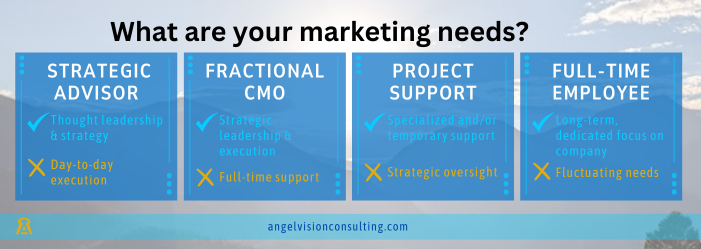What are your marketing needs?
Strategic Advisor? Fractional CMO? Project Support? Full-time Hire? Which one is right for your business?

As businesses grow, so do their marketing and branding needs. But when it comes to leadership, the big question is: Should you hire a strategic advisor, bring in a fractional CMO, contract for project support or commit to a full-time marketing leader?
Each option serves a different purpose, and choosing the right one can impact your business's growth, efficiency, and bottom line. Let’s break down when to use a strategic advisor, a fractional CMO, project support, and a full-time hire, so you can make the best decision for your business.
When to Hire a Strategic Advisor
A strategic advisor provides high-level guidance with limited or no hands-on execution. This is ideal when you need expert insights, direction, and industry knowledge but have an internal team (or external resources) to implement the strategy.
✅ Best for:
- Companies that need thought leadership and strategy but don’t require day-to-day execution.
- Businesses looking to optimize presence, content strategy, or brand positioning without hiring full-time.
- Founders, consultants, and executives who want a trusted advisor to refine their marketing or credibility-building efforts.
📌
Example Use Case:
A benefits consulting firm wants to position its leaders as industry thought leaders but doesn’t have the expertise to create a content strategy. A strategic advisor helps them craft the approach, outline a plan, and may guide initial development, but the internal team holds primary responsibilities to execute it.
👉 Choose a strategic advisor when you need expert-level insights, clarity, and guidance—without ongoing management.
When to Hire a Fractional CMO
A fractional CMO is a part-time executive-level marketer who provides both strategy and execution. They act as a hands-on leader, overseeing marketing initiatives without the cost or commitment of a full-time CMO.
✅ Best for:
- Growing businesses that need strategic leadership and execution but may not be ready for a full-time CMO.
- Companies in transition (scaling up, repositioning, or launching new offerings) that need senior-level marketing expertise.
- Organizations looking to build and optimize their marketing systems, content strategy, and lead generation.
📌
Example Use Case:
An insurance brokerage wants to increase brand visibility and inbound leads but doesn’t have an internal marketing leader. A fractional CMO develops their content strategy, lead generation system, and marketing execution plan—driving growth without the cost of a full-time CMO.
👉 Choose a fractional CMO when you need both strategic leadership and execution, but don’t need (or can’t afford) a full-time executive.
When to Contract Project Support
Contracted Project Support provides hands-on support in the execution of marketing initiatives or projects. They are focused on tactical execution of an established marketing plan or strategy.
✅ Best for:
- Businesses looking for specialized technical skills to execute their marketing strategy (i.e. design, marketing automation, email campaign support, SEO, website development)
- Companies looking for temporary support to augment team for specific initiatives or fill staffing gaps from their current team.
📌
Example Use Case:
A financial advisor is looking to refresh its brand with a mor modern look and feel including new logo, website and updated materials. It contracts one or more resources to assist in the execution of its brand refresh, which ensures all identified deliverables are completed timely and consistent with brand expectations.
👉 Choose Contracted Project Support when you need help with the execution of your marketing strategy for specialized technical skills or temporary support.
When to Hire a Full-Time Employee
A full-time marketing hire is ideal when your business has consistent, ongoing marketing needs that require a dedicated professional. Unlike a fractional CMO, a full-time employee focuses solely on your company, offering day-to-day execution and long-term commitment.
✅ Best for:
- Companies with established marketing functions needing dedicated execution.
- Businesses that require ongoing content creation, social media management, or campaign execution.
- Organizations with the budget to invest in a long-term marketing hire for growth.
📌
Example Use Case:
A financial services firm has built a strong marketing foundation with a fractional CMO but now needs a dedicated full-time marketing manager to handle content, social media, and client engagement on an ongoing basis.
👉 Choose a full-time hire when you need consistent execution, dedicated focus, and long-term marketing stability.
Next Steps
If you are looking to build credibility, optimize business growth or develop scalable marketing strategies, Angel Vision can help. Not sure which option is right for your business? Let's connect for
free discovery call.


